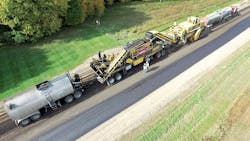A Good Candidate
Carver and Sibley Counties lie just southwest of the city of Minneapolis.
Topographically, the earth is relatively level, yet the area suffers the same aspects of roadway degradation as any other point in the state. As such, road maintenance and rehabilitation are key aspects of the Minnesota DOT’s (MnDOT) attack plan to provide safe throughways.
Cold in-place asphalt recycling (CIR), while employed at this point in a general way nationwide, is a fairly novel application in this area of Minnesota, according to MnDOT Project Manager Mathew Thibert.
“This technique is very new to our district,” Thibert told Roads & Bridges. “Prior to utilizing this technology, we observed a cold in-place project in the southwest MnDOT district. We were also aware of successful projects at the county level. After observing that project, we began to employ the technique on two projects on Highways 99 and 91.”
These twin applications proved successful, and laid the groundwork for a further use of CIR on the restoration of a 6.3-mile stretch of TH 5—a piece of road that was a good candidate for CIR.
“On this segment of Highway 5, the pavement distresses were primarily limited to thermal cracking,” Matthew Rottermond of MnDOT told Roads & Bridges. “A relatively thick layer of bituminous on this stretch lent itself well to CIR. It provided a thick enough section to support the equipment and not damage the underlying pavement materials.”
MnDOT assembled a project team that included construction management service provider Bolton & Menk Inc.; prime contractor Knife River, who provided surface paving; and Midstate Reclamation and Trucking, which provided milling and CIR services. Midstate Vice President of Business Development Dan Schellhammer saw right away that the MnDOT project team was correct in its estimation of the project site.
“The road was relatively straight,” Schellhammer told Roads & Bridges. “There were not many elevation changes. The road drove pretty rough, I have to say. There were a lot of transverse cracks. It was pretty well shot. Thankfully, the subgrade was good, so it was a really good candidate for CIR.”
GETTING DOWN TO WORK
Due to the thickness of the existing asphalt section, crews could afford to shave a little off the top before CIR work even began. This decision was practical for CIR operations and also provided a material source for shoulder work that would coincide with mainline paving and rescue.
“We milled off 3 in. of asphalt from the top, that’s how deep the level was,” Schellhammer said. “We were able to perform CIR on what was underneath that.”
Unfortunately, since this piece of road had been kept together year after year with band-aid maintenance techniques, getting those inches of asphalt off made for a bit of a challenge. Crack seal filler ran through the entire section like a network of veins—so much so that crews had to devote extra attention to keeping it out of the milled material as much as possible.
“Because we used a multi-unit train out there and our mill out front used a downward drum, it does a pretty good job of processing and sizing down that crack filler to start with,” Schellhammer recalled. “Nonetheless, we had to have an extra person out there to pull extra crack sealer out of there, off the screen deck, throughout the course of the job when the stuff got really heavy. And there was an awful lot of it. An awful lot. We removed as much as we could. We bagged and properly disposed of it, and the resulting material we kept looked good.”
The millings from this 3-in. removal would come in handy once the underlying CIR work was completed and a new wearing course was put down. Moreover, it aided the elimination of even slight elevation changes to the CIR work.
“Some of the 3-in. millings were used in the new HMA that was laid down and some was crushed down and made into the class 1 aggregate shouldering material,” Dan Franta, construction project engineer for Bolton & Menk, told Roads & Bridges. “They took that 3 in. off so they wouldn’t have a significant profile elevation change after performing the CIR and then laying the surface lifts. There were only a couple of small areas to patch, but it had nothing to do with the subgrade.”
Once the 3 in. of materials was gone, crews performed CIR on 4 in. at the full 14-ft width of each side of this bidirectional two-lane road—12-ft driving lanes with 2-ft paved shoulders on either side. (There were also 8-ft aggregate shoulders beyond that.) A full-lane CMI 1050 milling machine took the material off, feeding it to a Nesbitt CRMX-2 crusher with onboard pug mill. The cold mix was modified with an Ingevity emulsifier before being returned to the roadway by a Vogele paver. The paving width required the team to put a small Wirtgen W120 mill in front of the CIR train to process the full 14-ft lane width all in one pass. (“That mill made a huge, huge difference,” Franta recalled.)
Before the surface courses were applied, a change order was put through to apply a light fog seal following the CIR process: “MnDOT likes this and I do too,” Schellhammer said, “because it prevents raveling and helps with the cure.” Once the fog seal set, the road was finished with two 1.5-in. lifts of HMA Type 9.5 (4, F), consisting of 1/2-in. minus rock with an F oil PG 58-34, targeted at 4.0% voids, across the driving lanes and 2-ft shoulders in a single pass.
An incentive for pavement smoothness was built into the contract, for which the team earned 93% of the maximum ride incentive. Compaction was aided by Trimble intelligent compaction software, which Schellhammer, once a skeptic, now sees as essential to all Midstate operations.
“For us, it’s a critical quality control component at this point, for any job,” he said. “We began using this technology about five years ago, when MnDOT was starting to require it. Our operators were initially resistant to that process, because it was another thing to learn and keep track of, but now they prefer it. It’s kind of like playing a computer game—you just paint the whole thing the same color with your pass count. It helps us get assured and repeatable results throughout any job.”
The technology was installed on a pair of Hamm rollers—a double-drum steel run on vibratory and non-vibe, and a rubber tire—that buttoned up the job.
The project further reinforced MnDOT’s intention to pursue more CIR candidates in the future.
“A CIR generally has limited complexity and allows for a cross-slope correction during the initial milling,” Thibert said. “We have more CIR projects programmed for the coming year.”


